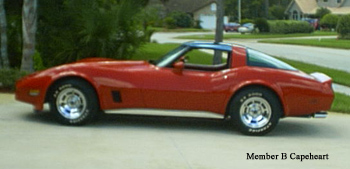
 “No other American car looks like or stirs the spirit like a Corvette,” said Chevrolet. The ’81 Corvette was essentially the same as the ‘80. There was no need to change, as it was selling strong, despite a slump in the auto industry.
“No other American car looks like or stirs the spirit like a Corvette,” said Chevrolet. The ’81 Corvette was essentially the same as the ‘80. There was no need to change, as it was selling strong, despite a slump in the auto industry. Lean, responsive and roadable, the Corvette met the needs of sophisticated sports car enthusiasts. It had, said Chevrolet pitch men, “All the style that makes Corvette instantly recognizable anywhere.”
Corvettes with Turbo Hydra-Matic automatic transmission featured a new fiberglass-reinforced mono-leaf rear leaf spring that weighed just eight pounds (33 pounds less than the old steel springs). The new fiberglass spring eliminated friction between leafs. Cars with manual gearboxes or optional Gymkhana suspension relied on the old type of spring.
With fuel economy on buyers’ minds, GM gave the ’81 Corvette thinner door windows that reduced the car’s overall eight. Even the new 190-hp RPO L81 350-cid V-8 used lightweight parts (like magnesium rocker arm covers). It still had a four-barrel carburetor. New low-restriction stainless-steel exhaust manifolds weighed 14 pounds less than cast iron manifolds.
A new thermostatically-controlled auxiliary electric fan boosted cooling and allowed use of a smaller main fan. The engine air cleaner had a new chrome-plated cover. A new Computer Command Control system controlled fuel metering. A four-speed fully synchronized manual transmission was available in all 50 states, making this option available to Californians for the first time in years. Cars with automatic transmission used a torque converter with a lock-up clutch that operated in second and third gears.
Electronic options were big again. A quartz crystal clock was used and the anti-theft alarm added a starter-interrupt device. Joining the option list was a 6-way power seat. Electronically-tuned radios were available with a choice of built-in cassette, 8-track tape player or CB transceiver. 
Four-wheel power disc brakes were standard in ’81 Corvettes, along with a limited-slip differential, power steering, full tinted glass, twin remote-control sport mirrors, concealed two-speed windshield wipers, halogen high-beam retractable headlights, air conditioning, power windows, a tilt-telescope leather-wrapped steering wheel, a tachometer, an AM/FM radio, a trip odometer, courtesy lights and a luggage compartment security shade. Corvette buyers had a choice of cloth-and-vinyl or leather-and-vinyl upholstery.
Even though the base Corvette was a fairly “loaded” automobile by this time, there still were options available. A new one was electrically-operated twin remote-control sport mirrors. Other options popular with collectors now include aluminum wheels, automatic speed control with resume, various Delco sound systems (including CB radios, 8-track players and cassette players) and a 6-way power driver’s seat. The optional Gymkhana suspension (price $54) was also included with the trailer towing package.
Corvettes were made in St. Louis early in the year and inj a new plant in Bowling Green, Ken., later on. First and last serial numbers were [St. Louis Assembly Plant] 1G1AY87[ ]4BS400001 to 1G1AY87[ ]4BS431611. [Bowling Green Assembly Plant] 1G1AY87[ ]4B5100001 to 1G1AY87[ ]4B5108995.
The first symbol indicates U.S. car. The second symbol G indicates General Motors product. The third symbol 1 indicates Chevy. The fourth symbol A indicates restraint system used. The fifth symbol Y indicates Corvette. The sixth and seventh symbols indicate two-door coupe. The eighth symbol indicates engine. The ninth symbol is a check digit that varies. The 10th symbol indicates model year. The 11th symbol indicates the assembly plant: S=St. Louis and 5=Bowling Green. Last comes the sequential production number starting with 100001 at each factory.
The 1981 Corvette coupe retailed for $16,258 and 40,606 were made. Their vital statistics included a 98-inch wheelbase, a 185.3-inch overall length and P225/70R15/B SBR tires.
|
'81 VETTE FACTS
|
|
|
VEHICLE IDENTIFICATION NUMBER
|
For St. Louis Assembly Pant 1G1AY87[ ]4BS400001 to 1G1AY87[ ]4BS431611. For Bowling Green Assembly Plant 1G1AY87[ ]4B5100001 to 1G1AY87[ ]4B5108995. The first symbol (1) indicates US built. The second symbol (G) indicates GM product. The third symbol (1) indicates Chevrolet. The fourth symbol (A) indicates the type of non-passive passenger restraint system used. The fifth symbol (Y) indicates car lne or series Corvette. The sixth and seventh symbols indicate the body style number 87=two-door plainback special coupe. The eighth symbol [in blank] indicates engine: 6=L82 350-cid (5.7 liter) 230-hp V8. The ninth symbol is a check digit that varies. The 10th symbol indcates model year B=1981. The llth symbol indicates the assembly plant S=St. Louis and 5=Bowling Green. The last six symbols indicate the sequential production number starting with 100001 at each factory.
|
|
ENGINE
|
BASE ENGINE
Type: V-8
Bore and stroke: 4.00 x 3.48 in.
Displacement: 350 cid
Brake hp: 190 at 4200 rpm.
Induction: Rochester Quadrajet
|
|
VITAL STATS
|
Coupe
Original Price: $16,258.52
Production: 40,606
Wheelbase: 98 in.
Length: 185.3 in.
Tires: P225/70-R-15/B SBR
|
|
COOL STUFF
|
• Last model to have a manual transmission available until well into the 1984 production year.
• Two-tone Paint (D84) $399.
|